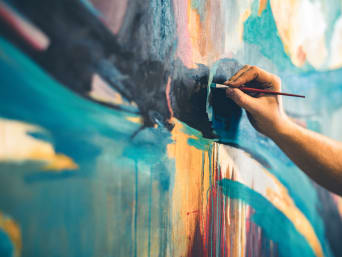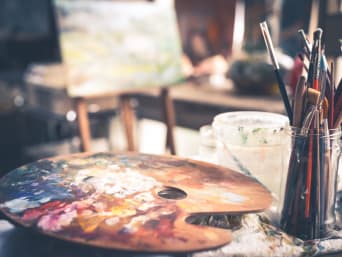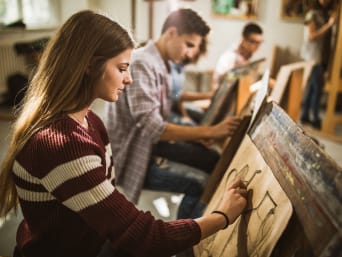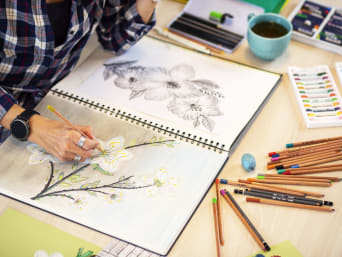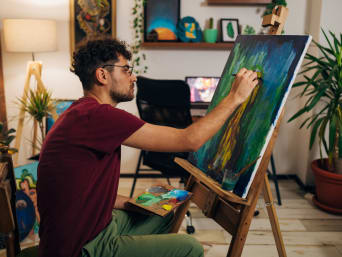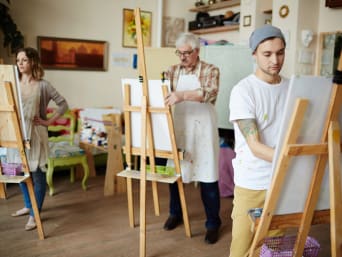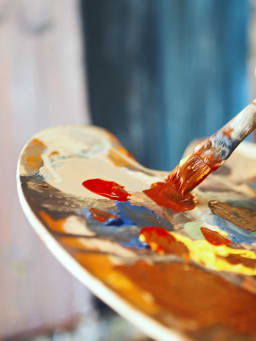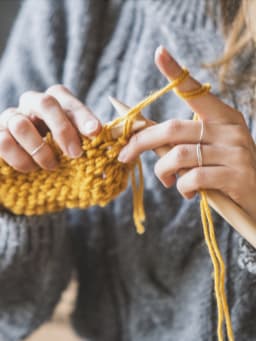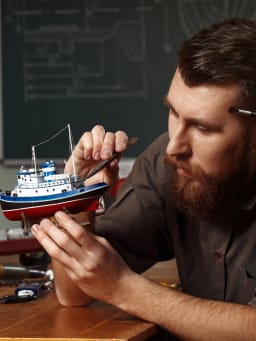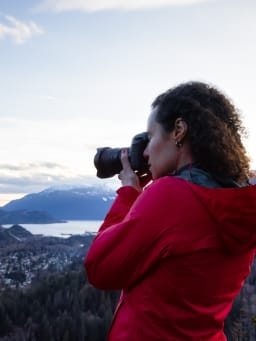Painting and drawing for beginners: creative hobbies for adults
Art allows you to get creative and to express thoughts and feelings for which words are not enough. Drawing and painting are great hobbies to give you a break from everyday life. In this article we will show you how to get started with these hobbies and what you will need as a beginner.
Learning to draw and paint
The main thing is you spend time doing something you enjoy even if you cannot draw or paint. There are many benefits to creating art by drawing and painting:
Drawing and painting can improve your mood. Instead of stressing about everyday things, your focus is on your artwork. This can help you to relax and find yourself again.
They improve your fine motor skills and hand-eye coordination. As you have to perfect even the smallest movements to complete the details of your artwork, you can refine your motor skills. This in turn can have a positive effect on other activities that require dexterity and coordination, for example, sports or model making.
Your cognitive skills improve. Even though drawing and painting are relaxing and even meditative for many artists, you also stimulate different areas of the brain that are responsible for creativity, concentration, and analytical thinking.

As any experienced artist will tell you, high-quality tools are essential for growing and creating as you develop. This does not mean, however, that a beginner must immediately buy expensive art sets and drawing tools. Firstly, you should start off with just a couple of things to find out whether you will continue with it long term.
Drawing for beginners
If you want to learn to draw, patience and diligence are key to success. It may take some time before you see the progress, therefore, it’s important not to become demotivated and to pursue your new hobby. Try not to lose the enjoyment by being too critical of your work. We have put together some tips that you can follow to help learn how to draw:
Doodling is an important exercise. So don’t put yourself under pressure to produce only perfect works of art on your drawing pad right from the start.
Start off by drawing simple things, e.g. a single object in your room and not a whole still life straight away.
Apply light pressure to your pencil when sketching. Delicate lines are easier to correct and erase.
Don’t set your sights too high. First develop your eye for perspective and proportions before you concentrate on lifelike details, shades and structures.
Beginners are usually not able to draw from memory without making mistakes. Find templates and, if necessary, use guidelines or simple geometric shapes to base your drawings on. Even tracing or copying can help you practise your fine motor skills you will need for drawing.
Drawing tools: what you will need to get started
Drawing is a hobby that you can start at any time with just a few basic items. However, you will need more drawing supplies when you are more advanced.
Quality drawing paper (approx. 120 - 190 g/m²)
Pencils in various degrees of hardness (e.g. a beginner’s set from an artist’s supply shop)
Eraser (soft)
Sharpener
If you do not want to draw exclusively with pencils, you can add some coloured pencils or felt-tip pens to art supplies.
Tip: Go to a specialist shop for advice on choosing the right drawing tools. If you are unsure, you can look for recommendations from other artists online. You may also find recommendations for the products you need on the materials list from art courses and art schools.
Painting for beginners
Instead of fiddling with pencils and drawing on paper, would you rather express your creativity with brushes and bright colours? To master painting, however, you will need to familiarise yourself with paint sets and accessories and the different techniques. If you want to dive straight into painting, below we have put together some helpful tips that you can follow:
Good drawing skills make a useful base for painting. This will help you develop your artistic eye and fine motor skills. These skills are indispensable for painting, even if you want to paint in an abstract style rather than a natural one.
Familiarise yourself with the basic theories of painting. As with drawing, shapes, proportions and perspectives are the cornerstones of a successful painting. You should also familiarise yourself with colour theory to achieve the right colour effect (e.g. harmonious, rich in contrast, etc.).
Do not start with difficult paints. Instead of oil paints, which are more difficult to handle and often require special primers, you could start with acrylic paints instead. If you are still very inexperienced, a basic paint set with watercolours would work for your first try.
When learning to paint don’t be too self-critical. Especially as a beginner, you will not immediately conjure up perfect masterpieces. If you set yourself realistic goals and start with simple motifs, you will be more satisfied with your results and will be able to improve more and more. Even a painting that didn’t turn out how you wanted it to is a valuable exercise from which you can learn.
Start by sketching your painting with light pencil lines. This allows you to make corrections before you pick up your brush. If you want to paint more spontaneously, you can also get creative and by picking up a brush and painting something that pops into your mind.
Painting accessories: what you will need to get started
Depending on which painting technique you choose, make sure you have the following basic painting tools:
Colours (e.g. acrylics, watercolours, pastels): Starter sets usually contain yellow, red, blue, green, ochre, brown, black and white.
About 5 to 10 flat and round brushes in different sizes: If you work with different colours (e.g. acrylic paints, oil paints, watercolours), you should have a separate set of brushes for each type of paint.
Palette for mixing the colours
Suitable painting surface: e.g. cartridge paper with sufficient thickness/painting board, canvas (incl. easel), stronger watercolour paper (> 200 g/m²).
Tip: If you are unsure about your choice of colours, brushes and painting surface, it is best to seek advice from an art expert or art school. It’s also a good idea if you are more advanced and want to try out new tools (e.g. painting knives for the impasto technique).
Pursuing drawing and painting as a hobby
Even if you have never held a paintbrush in your hand, you can still get started with these artistic hobbies. Learning how to draw and paint is an ideal way to balance out your everyday working life or a fun new hobby for anybody that is retired.
Getting started with drawing and painting depends on how you would like to learn.
Art courses: learning how to paint and draw
You will get direct feedback, valuable tips and inspiration from other artists on your art course. This will help you to learn and improve your artistic skills. If you attend group classes, you will meet other people who are learning how to draw and paint. You can get to know some new perspectives and styles and it might be easier for you to stay motivated.

When learning to draw or paint, only one thing helps: practice, practice and more practice! Although some talent can give you a small head start in learning, ultimately art is something that needs constant practice. So don’t be discouraged if you find it difficult at first to get started with your new hobby.
Learning to draw and paint from books
Books mainly teach you the theory of drawing. With the help of illustrative pictures, you can learn more about techniques and methods and often practise them with illustrated step-by-step instructions. Try your local library to test out some books before you buy.
Video tutorials or DVD courses for learning how to paint and draw
If you want to refresh your knowledge or learn new techniques, video tutorials are a good option. There is a lot to choose from make sure you find a video tutorial that suits your skill level. YouTube videos that only show a quick run-through of the process of creating a painting are more for inspiration, whereas step-by-step instructions are good for learning more about drawing and painting.

If you are looking for an exchange with like-minded people, it is a good idea to attend local art courses. Various online communities, for example, forums, blogs and social media sites can also help you to find, tips, support and mutual inspiration.
Conclusion: drawing and painting for beginners
If you are looking for a new hobby that not only develops your creative skills, but also allows you to relax and unwind, then drawing and painting is just the thing for you. There are countless ways you can learn how to draw and paint. You can attend an art course, watch video tutorials or learn by reading books. Just pick up a pen or brush and get creative!
______________________________________________
References and further information:
https://www.artsy.net/article/artsy-editorial-pencils-papers-erasers-start-drawing
(Last accessed on 23.11.2023)
https://design.tutsplus.com/tutorials/how-to-learn-to-draw-stage-one-manual-skills--cms-23304
(Last accessed on 23.11.2023)
https://feelingnifty.com/acrylic-painting-tips-beginners/
(Last accessed on 23.11.2023)
https://www.linkedin.com/pulse/10-great-health-benefits-painting-drawing-hessam-moussavi
(Last accessed on 23.11.2023)
https://www.pinotspalette.com/blog/creative-life/how-to-paint-for-beginners
(Last accessed on 23.11.2023)
The image sources in this text are in chronological order:
Cover photo: iStock.com/FOTOGRAFIA INC.
1. Image in text: iStock.com/AlexD75
2. Image in text: iStock.com/skynesher
3. Image in text: iStock.com/Sladic
4. Image in text: iStock.com/Kosamtu
5. Image in text: iStock.com/shironosov
